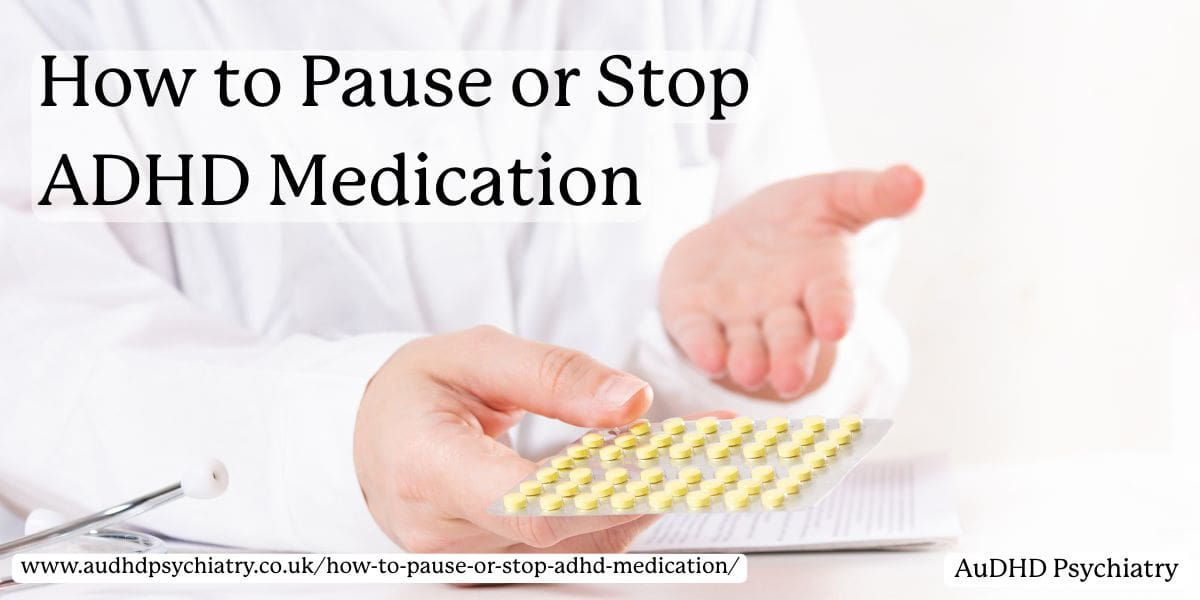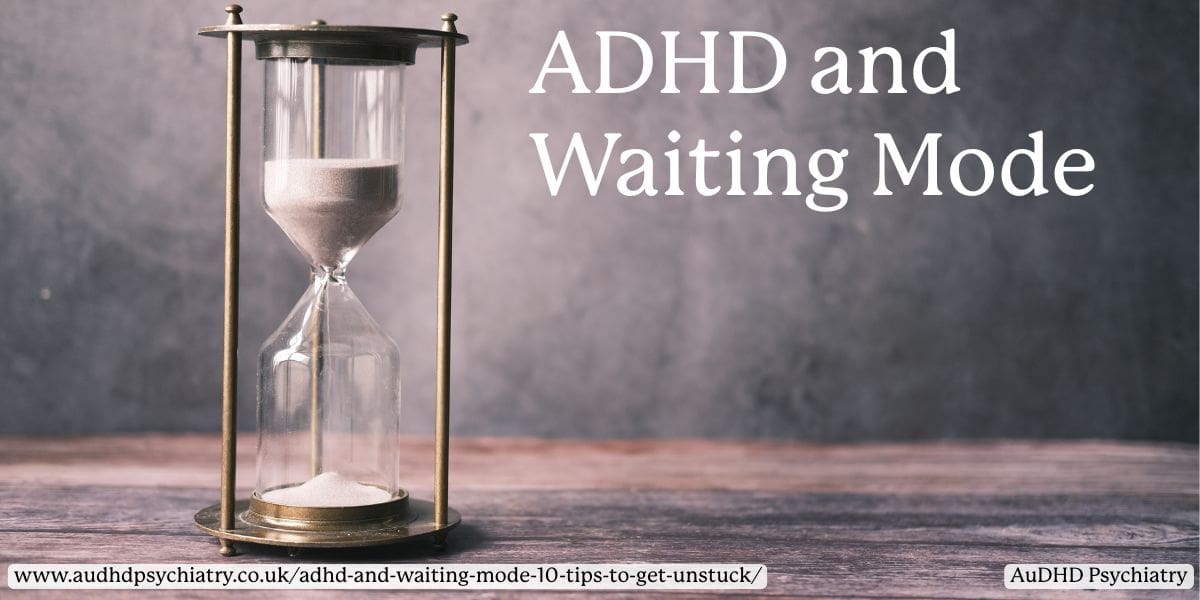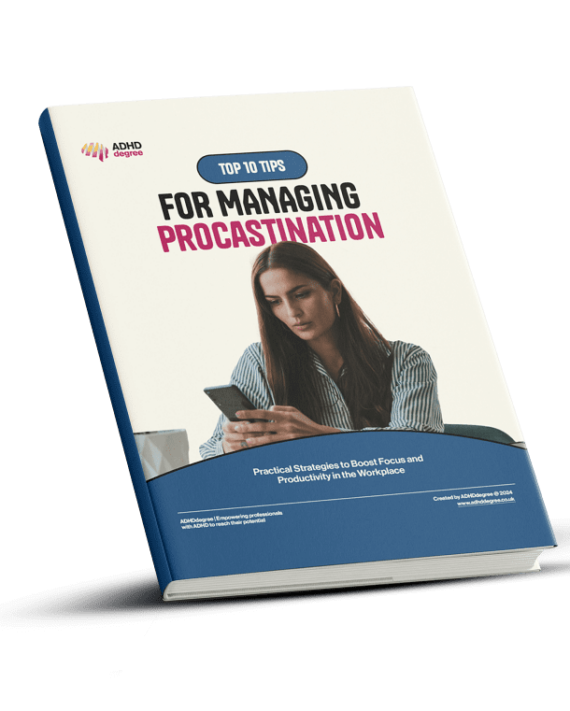What happens if you stop taking ADHD medication, even just for the weekend? If you’re experiencing bothersome side effects, planning for work or school breaks, or wondering if your current prescription is still the right fit, pausing ADHD medication requires careful planning.
Many individuals, including adults and parents of children with ADHD, consider taking a “medication holiday” to reduce side effects like appetite loss, manage emotional changes, or re-evaluate whether the stimulant drugs still meet treatment needs. But ADHD medication directly affects the central nervous system, so stopping suddenly can lead to rebound symptoms, emotional dysregulation, or a drop in focus and impulse control.
In this guide, we’ll explain how to stop or pause ADHD medication safely, with the support of your healthcare provider, a clear monitoring strategy, and alternative tools like behavioural therapy or non-stimulant medication. You’ll also learn the difference between tapering, short breaks, and complete discontinuation.
If you’re someone looking to get a diagnosis for ADHD, you can start by reviewing your symptoms with our free online ADHD test, then explore the options available to you. We’ll share more about this in later sections.
Is It Safe to Stop ADHD Medication?
Stopping ADHD medication is not as simple as missing a dose. Stimulant medications alter levels of neurotransmitters such as dopamine and norepinephrine, so abrupt changes can lead to ADHD medication withdrawal or a rebound in hyperactivity, impulsivity, and inattention. The risks may be particularly high in individuals on higher doses or with coexisting conditions such as bipolar disorder or cardiovascular disease.
The Risks of Stopping Without Medical Guidance
Stimulant ADHD medications, including methylphenidate and amphetamines, are classified as controlled substances. This classification reflects their potential impact on the central nervous system and underscores the importance of medical oversight. Sudden discontinuation without clinical guidance can result in side effects such as irritability, fatigue, mood fluctuations, or increased heart rate.
When a Medication Break May Be Appropriate
However, there are cases where a planned medication break may be appropriate. For example, during school holidays, summer vacation, or reassessment periods, some individuals may temporarily pause medication under professional supervision. In these instances, a tapering plan and consistent monitoring can help reduce risk. We will discuss this in further detail in the next section.
For further information on figuring out if your current meds align with your treatment goals, read our article on ADHD medication dosage. You’ll learn specific guidelines, such as when to increase ADHD medication in adults, or when it’s time to talk to your clinician to decrease doses.
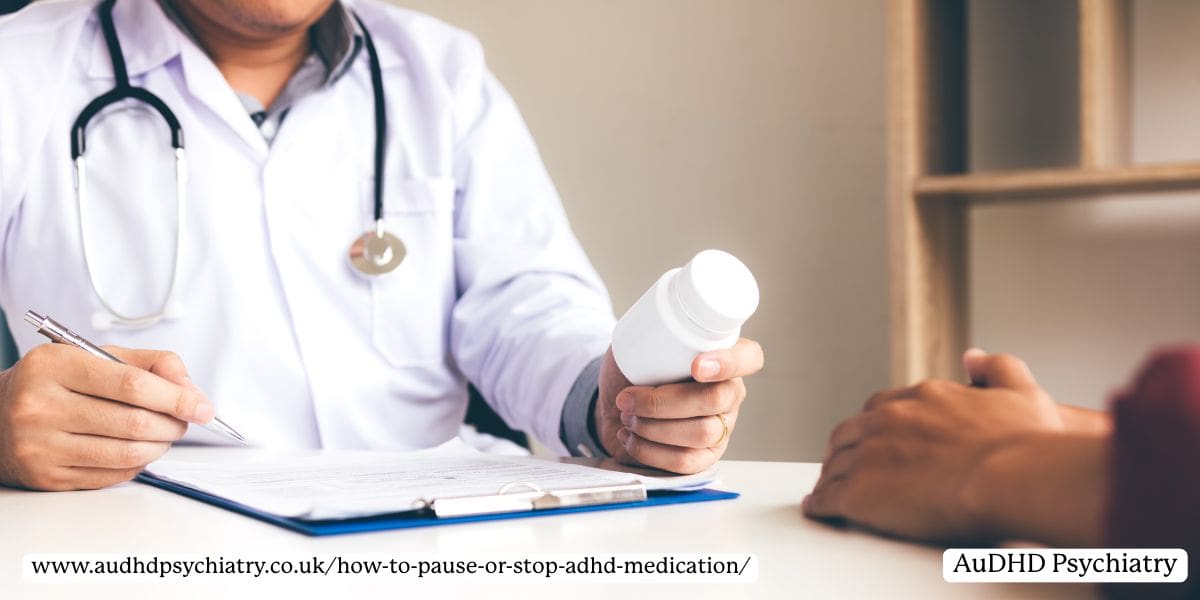
When Should You Consider a Medication Break or Stop?
There are several valid reasons for considering a pause in ADHD medication, ranging from managing bothersome side effects to evaluating long-term treatment needs. Children may benefit from medication breaks during summer holidays to reduce appetite suppression or growth-related concerns. Adults might consider a pause during reduced work demands or in preparation for a treatment reassessment.
Signs It Might Be Time to Stop
Other individuals may seek to stop ADHD medication entirely if they have developed new coping skills, their symptoms have changed, or if alternative therapies are now available. However, this decision must always be made in collaboration with a healthcare provider, especially when stimulant drugs are involved.
Drug Holidays and Symptom Tolerance
In some cases, a drug holiday may be used to reduce tolerance or mitigate side effects. These short breaks, such as skipping medication on weekends or during non-academic periods, are more commonly trialled with younger patients but may also be suitable for adults.
If you are unsure whether a break is appropriate, consider discussing your goals with your healthcare provider. Before making changes to your treatment, you may also find it useful to start with a symptom screener or consult our guide on common ADHD symptoms.
Talk to Your Doctor First
Before making any changes to your ADHD medication routine, schedule a consultation with your prescribing healthcare professional. They’ll evaluate several factors including your ADHD symptoms, treatment history, coexisting conditions, and current support system, before recommending whether a break or discontinuation is appropriate.
Questions to Ask at Your Appointment
Start by preparing your list of questions, which may include: “Is it safe to try a medication break?” “What will we monitor?” and “What are the risks based on my medical history?” These questions help clarify expectations and ensure your treatment plan stays personalised and safe.
Questions to Ask at Your Appointment
Your healthcare provider may also review whether you’re using an immediate-release or extended-release medication, as tapering methods differ for each. In cases where a pause is recommended, they may propose a step-down dosing strategy to reduce the risk of rebound effects.
Keep in mind that adjusting or pausing prescription medications without clinical supervision may increase health risks. For tips on managing changes in medication and understanding potential side effects, refer to our guide on managing ADHD medication side effects. It’s critical to involve your healthcare provider if you have a coexisting condition such as anxiety, depression, or a history of substance use, as these can influence how your body responds to changes in medication.
Short-Term vs Long-Term Medication Breaks
There are mainly two different types of ADHD medication pauses: short-term breaks, such as skipping doses on weekends or during school holidays, and long-term discontinuation, often used to assess ongoing need or to manage side effects.
Short breaks, sometimes called medication holidays, can be helpful for reducing side effects like weight loss or high blood pressure. They’re more commonly used with children or adolescents, especially during times when academic performance is not as critical. However, even short breaks should be supervised to avoid a sudden return of symptoms.
Longer pauses or full discontinuation may be appropriate when the individual no longer meets the clinical threshold for treatment or when medication side effects outweigh the benefits. This is often discussed during follow-up visits or annual treatment reviews.
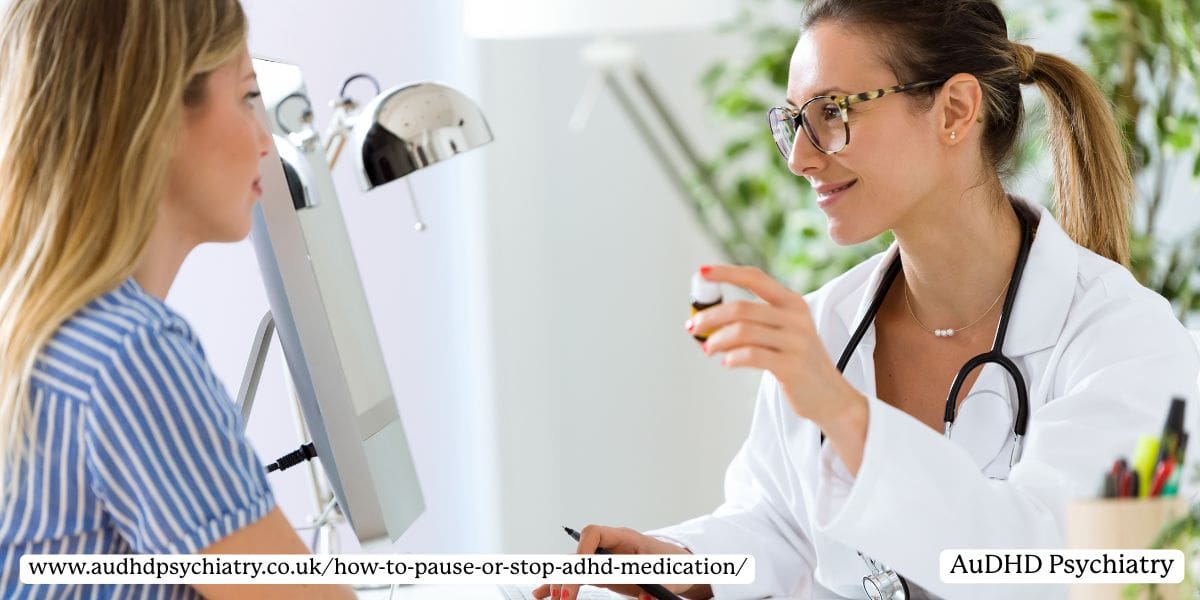
How to Taper Off ADHD Medication Safely
If your healthcare provider recommends stopping medication, they will usually advise a tapering approach rather than immediate cessation. Gradually reducing the dose over time allows your brain and body to adjust to changing levels of dopamine and norepinephrine. This minimises the risk of withdrawal symptoms, such as fatigue, mood swings, irritability, or a sudden return of ADHD symptoms.
Tapering Guidelines for Stimulant vs Non-Stimulant Medication
Tapering methods differ depending on the type of medication. For example, stimulant ADHD medications such as methylphenidate or lisdexamfetamine often require a step-down approach, especially if taken in extended-release form. Non-stimulant options like atomoxetine (Strattera) or guanfacine need even more caution, as they interact with the cardiovascular system and may lead to rebound symptoms or blood pressure changes if stopped too quickly.
Monitoring During the Tapering Process
During this time, you should track any emotional or behavioural shifts, appetite changes, sleep disturbances, or return of impulsive behaviour. Keeping a medication journal or symptom log can support more informed conversations with your healthcare provider.
What to Expect After Stopping ADHD Medication
Stopping ADHD medication, whether short-term or permanently, can lead to varying physical, emotional, and cognitive changes. This is particularly true for individuals who have been on stimulant drugs for an extended period or at higher doses. The impact may look different depending on the type of medication, duration of use, and whether a tapering protocol was followed.
Potential Withdrawal and Rebound Symptoms
Some people experience withdrawal symptoms like irritability, sleep problems, low energy, or changes in mood. Rebound symptoms are also common, including a temporary intensification of ADHD symptoms like impulsivity or inattention. These reactions occur as the body adjusts to lower levels of neurotransmitters such as dopamine.
Symptom Return and Timeline
In many cases, ADHD symptoms may return within days of stopping medication, especially if it was effective in managing focus, emotional regulation, or behavioural issues. However, not everyone will experience a significant decline. Some individuals, particularly those who have built effective coping strategies, may continue functioning well without medication.
Managing ADHD During a Medication Pause
Going without medication does not mean going without support. If you’re taking a break, it’s important to adopt strategies that help reduce the impact of ADHD symptoms in daily life. Many individuals turn to behavioural interventions and lifestyle changes during this period to help maintain focus, emotional regulation, and impulse control.
Daily Routines and Behavioural Tools
Creating a structured environment can significantly ease the transition. Use checklists, reminders, and consistent routines to reduce cognitive load. Children benefit from visual schedules and regular feedback, while adults may find timers, productivity apps, or ADHD coaching useful during this time.
Lifestyle Factors That Support Symptom Management
Sleep, nutrition, and physical activity are essential parts of non-medication ADHD treatment. Limiting processed foods, avoiding excessive caffeine, and establishing consistent sleep hygiene routines can all improve attention and mood regulation. You can explore this more in our blog about how exercise supports ADHD management.

Support Systems and Therapy
External support can play a helpful role, whether through school accommodations, workplace adjustments, or therapeutic interventions like CBT. Involving family members or teachers helps reinforce progress and identify early signs of regression. For adults who need help managing ADHD in the workplace, personalised strategies such as task prioritisation tools, environmental modifications, and flexible scheduling can make a meaningful difference in daily functioning and long-term productivity.
Tracking Progress During a Break
Monitoring how you or your child responds to a medication pause is key to understanding whether the break is helpful or needs adjustment. Tracking also supports better decision-making during follow-up appointments.
Start by documenting sleep patterns, mood shifts, changes in attention span, emotional outbursts, or difficulties with organisation. These notes can be kept in a digital app, spreadsheet, or physical journal. Track frequency, intensity, and situations where symptoms occur.
Signs That Indicate Improvement or Regression
Improvement may look like fewer emotional outbursts, better social interactions, or reduced reliance on reminders. Regression might appear as missed deadlines, renewed hyperactivity, or academic and behavioural challenges. If signs of regression occur, it may be time to consult your healthcare provider or consider restarting medication. If you’re unsure what to look for, our guide on common ADHD symptoms provides a helpful reference point during this observation period.
Restarting ADHD Medication After a Break
Resuming ADHD medication after a pause should be approached with the same level of care as when starting treatment for the first time. Whether the break was short-term or part of a structured discontinuation trial, reintroducing medication involves clinical reassessment, dosage adjustments, and symptom tracking to ensure safety and effectiveness. Restarting ADHD medication is not simply a matter of picking up where you left off, especially if the break lasted more than a few weeks.
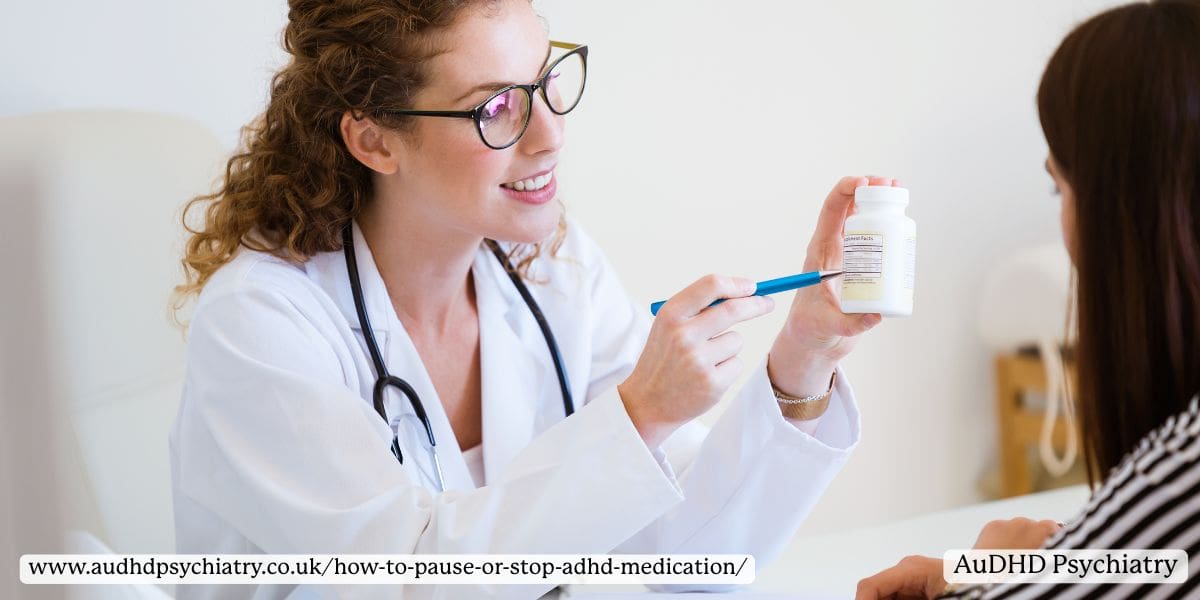
Why Restarting Requires Medical Supervision
Many individuals assume they can resume their previous prescription at the same dosage. However, this may not be suitable, particularly for stimulant ADHD medications such as methylphenidate or lisdexamfetamine. Your healthcare provider may recommend beginning with a lower dose to assess tolerance, monitor for unwanted side effects, and evaluate whether the same medication is still the best option. This is particularly important in cases where other health conditions, such as high blood pressure, anxiety, or sleep problems, have developed during the break.
Non-stimulant medication, such as atomoxetine or guanfacine, may also require a gradual reintroduction to reduce the risk of cardiovascular changes or other complications. These selective norepinephrine reuptake inhibitors (SNRIs) act differently from stimulants and often take longer to reach full therapeutic effect.
What to Expect When Restarting Medication
Some individuals may notice improved symptom control immediately upon restarting medication, while others may experience delayed or reduced effectiveness. This could be due to brain chemistry changes, dosage differences, or new coexisting conditions. Appetite loss, sleep disruption, and changes in heart rate may also occur, especially when returning to stimulant drugs.
If your response differs significantly from before, your provider might prescribe trying a different medication or formulation. For example, you may switch from an extended-release to an immediate-release option to accommodate changes in daily routine or improve dose flexibility.
As always, you should work closely with your healthcare provider to monitor any physical or emotional side effects. If you’re unsure which medication to restart or how to reintroduce it, our guide to comparing Adderall, Ritalin, and Vyvanse may help inform your conversation with your clinician.
Common Mistakes to Avoid When Restarting
Restarting ADHD medication is a clinical decision that should always be tailored to individual needs. One common mistake is assuming that symptoms will respond the same way as before. Different factors can influence how well the medication works. Another misstep is failing to track progress after restarting – without a clear record of symptom patterns, it becomes difficult to assess whether the drug and dosage are effective.
What to Avoid When Restarting ADHD Medication
Some individuals also resume their previous ADHD meds without updating their healthcare provider on recent changes in health or lifestyle, such as increased alcohol consumption, use of herbal medicines, or new prescriptions for unrelated conditions. These can interfere with drug metabolism or increase the risk of side effects, particularly in stimulant medications.
How to Restart Medication Properly
To reduce risk and optimise treatment outcomes, always follow a titration plan, monitor closely for bothersome side effects like sleep problems or appetite suppression, and maintain regular check-ins with your healthcare provider. This ensures that the reintroduction of medication remains part of a well-monitored, personalised ADHD treatment strategy.
Will the Medication Still Work the Same Way?
A common concern is whether the ADHD medication will still be effective after a break. Most stimulant medications, including extended-release and immediate-release formats, retain their effectiveness when reintroduced. However, factors such as age, changes in body weight, or emerging health risks, such as high blood pressure or heart rate irregularities, may alter how your body processes the medication.
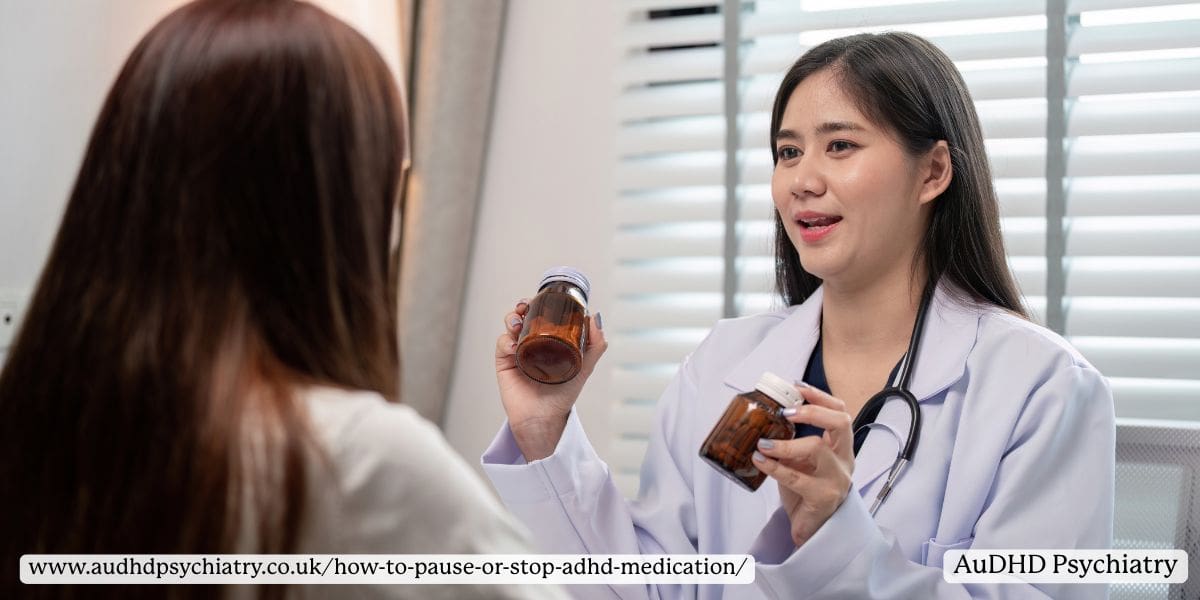
What If My ADHD Medication Is No Longer Effective?
If the same treatment is no longer as effective, your provider may suggest switching ADHD medications. You might be prescribed a non-stimulant option such as atomoxetine or guanfacine, especially if previous stimulant use led to serious side effects or increased risk of substance misuse. You can learn more about stimulant vs non-stimulant ADHD medication in our overview on ADHD medication types.
Before restarting medication, ensure you have access to a pharmacy or service provider, whether through the NHS or a private clinic. During periods of limited availability, such as the current ADHD medication shortage in the UK, your provider can guide you on interim options or alternate treatment plans.
FAQs
What are the cons and pros of ADHD medication breaks?
Pros include reduced appetite loss, lower risk of side effects, and opportunities to assess coping strategies. Cons of a drug holiday may involve symptom rebound, sleep disturbances, or emotional dysregulation. For some, stopping medication disrupts school or work performance. A supervised break offers the best chance to weigh benefits against drawbacks.
When should adults increase their ADHD medication dosage?
In adults, dosage increases are typically considered when current levels are no longer managing inattention, impulsivity, or focus issues effectively. It’s important not to increase ADHD medication without medical supervision. Your provider may adjust the dose during a follow-up visit based on symptom tracking, side effects, and treatment goals.
Can I travel internationally with ADHD medication, or should I skip?
Travelling with ADHD medication, especially stimulant drugs, requires planning. Because many are classified as controlled substances, some countries may restrict or prohibit entry with these prescriptions. Always check legal regulations and bring supporting documents. For tips on travelling with ADHD meds, refer to our ADHD medication and prescription guidance resources.\
What is a structured treatment interruption in ADHD?
A structured treatment interruption is a planned pause from medication to observe how symptoms change without pharmaceutical support. Often used in young children or during summer vacation, it helps clinicians and families decide whether medication is still needed or if other interventions suffice.
Can adults stop ADHD medication permanently?
Some adults choose to discontinue medication if they develop coping mechanisms, experience fewer symptoms, or face unwanted side effects. This decision must be based on consistent symptom assessment and guidance from a healthcare provider. Cognitive behavioural therapy or ADHD coaching may serve as helpful non-medication alternatives.
How to Pause or Stop ADHD Medication: Conclusion
Taking a break from ADHD medication can be a helpful part of long-term ADHD treatment when done thoughtfully and under medical supervision. If you’re pausing due to unwanted side effects, a summer break, or to evaluate the medication effectiveness, it’s essential to consider the impact on your focus, emotional stress, and overall mental health.
Many individuals assume that coming off ADHD meds is straightforward, but factors like impulsive behaviour, coexisting conditions, or a family history of mental illness may increase the risks. Structured pauses can sometimes reduce treatment fatigue or limit substance use disorders, particularly when stimulant drugs are involved.
Working with a healthcare provider helps ensure your treatment plan continues to meet your goals. You might explore non-stimulant ADHD medication or tricyclic antidepressant options if stimulant-related side effects have become disruptive. During a medication holiday, techniques like ADHD coaching, CBT, and coping skills training can support your progress.
Medication breaks are not for everyone, but with the right strategy, they can be a good idea for reassessing what works best. To get expert advice tailored to your situation, book a private ADHD assessment with our team today.

